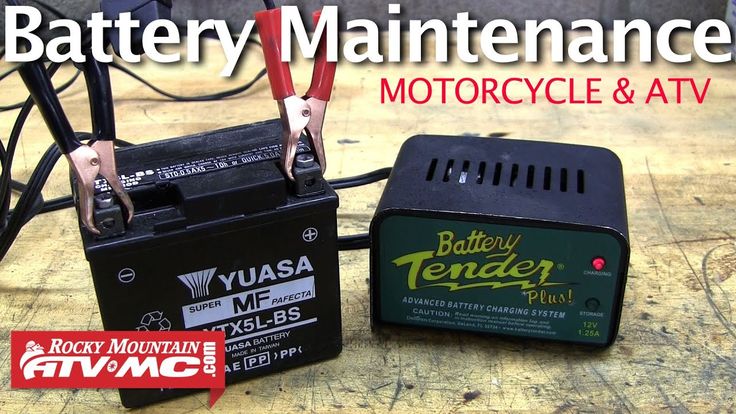Just like how you can't go without water, neither can your battery. Watering your lead acid battery is an essential maintenance step that can't be skipped. It keeps your battery safe for use and in optimal condition. Not watering your lead acid battery at the right time can lead to serious damage, but knowing when is the right time to water your battery isn't always easy. Follow these steps on how to water your lead acid battery.
Lead acid batteries consist of flat lead plates immersed in a pool of electrolyte. The electrolyte consists of water and sulfuric acid. The size of the battery plates and amount of electrolyte determines the amount of charge lead acid batteries can store or how many hours of use. Water is key part of how a lead battery functions.
Additionally, during the recharging process as electricity flows through the water portion of the electrolyte, water is converted into its original elements, hydrogen and oxygen. These gasses are very flammable and the reason your RV or marine batteries must be vented outside. Gassing causes water loss, which is why lead acid batteries need to have water added periodically. Low maintenance batteries like AGM batteries, are the exception because they have the ability to compensate for water loss.
Overwatering and under watering can both damage your battery. To keep your lead battery running at peak levels, follow these watering guidelines.
First – Start with Safety
To get started, make sure to wear personal protection equipment such as protective eyewear and gloves when working on batteries. Also, it is very important to understand that some batteries require regular watering service – while other batteries deliver maintenance-free operation.
Make sure to look for information on the battery labeling that indicate whether the battery can be opened and serviced. Depending upon the battery type you are using, the warning labels on your battery should direct you to “DO NOT OPEN” the battery, or “KEEP VENT CAPS TIGHT FOLLOWING WATERING SERVICE. ” Make sure to follow the warning label instructions.
” Make sure to follow the warning label instructions.
While a battery should only be filled after it is completely charged, you should also check the water level before charging to make sure there is just enough water to cover any exposed plates. After charging, add enough water to bring the level to the bottom of the vent, about ¾ below the top of the cell.
It’s important to note that battery owners should never add sulfuric acid to their battery. During normal operation batteries will only consume water – and not sulfuric acid. When your battery’s electrolyte is observed to be low, filling the battery with water will keep the battery healthy and safe for use.
Don’t Over Water
While a battery is charging, the density of the electrolyte solution will increase. If too much water was added before charging, the electrolyte levels will expand and cause the battery to overflow and damage the battery.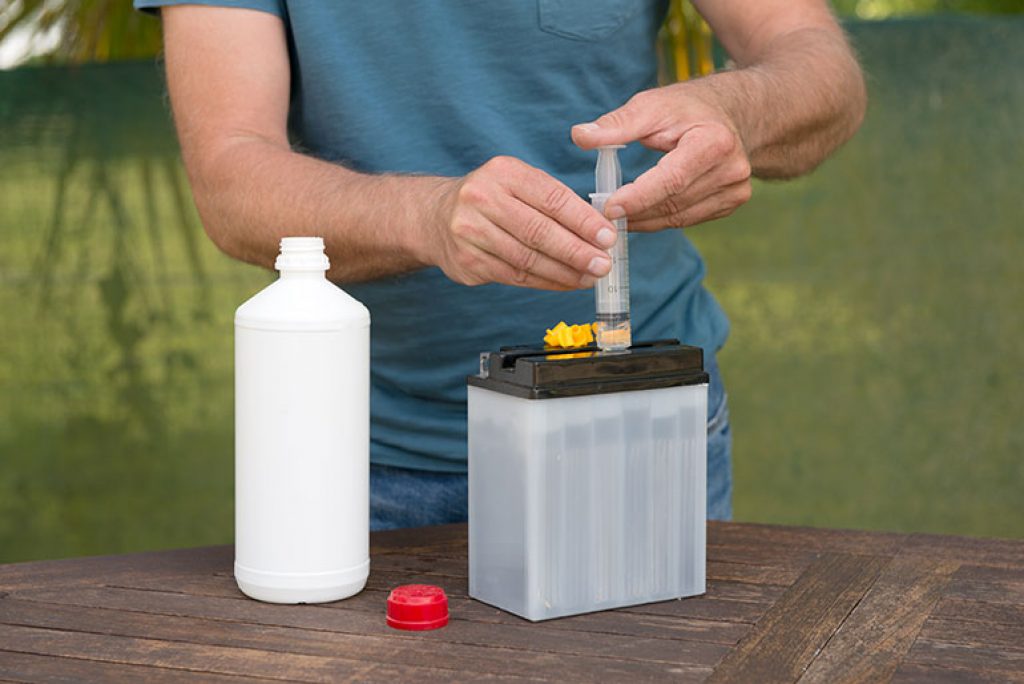 Additionally, excessive watering of a battery can result in additional dilution of the electrolyte, resulting in reduced battery performance.
Additionally, excessive watering of a battery can result in additional dilution of the electrolyte, resulting in reduced battery performance.
How often you add water to your battery will depend on how often you use it. A golf cart battery that is only used on the weekends may only require once a month watering. A forklift used all day, every day, may need to have its battery watered every week. When the weather is hot, this will increase the need for watering. It’s important to check your battery’s fluid level regularly – and the best practice is to do so after the battery is finished charging.
What type of water should be used
Avoid using tap water. When filling your battery, regular tap water isn’t going to cut it. Tap water contains minerals that are harmful to batteries, even if added in small amounts. This is particularly true for water softened by water softeners which contain chlorides. To be safe, distilled water is your best bet and is a much smaller investment than a new battery.
Remember, that water will sit on top of the acid solution in your battery until it is mixed by the bubbling produced by charging. If you are taking hydrometer readings of the electrolyte, it’s best to take them after charging is complete.
Don’t let your battery get dehydrated. Keep it watered during hot months and all year long.
When your ATV gets older and has been used a lot, there will be inevitable maintenance that needs to be done. When you are doing regular maintenance, you will find yourself looking at your ATV battery and wondering what you must do, and whether you need to occasionally need to change the water.
Yes, ATV batteries need water. Most ATVs still use lead-acid batteries that will need to be maintained using distilled water. You must regularly check the levels of your battery and make sure that it is at the right level.
The problem, however, is that not all ATVs are the same, and newer vehicles will have different battery types, requiring different maintenance. Most new owners will be confused about what distilled water is, and where to get it.
Most new owners will be confused about what distilled water is, and where to get it.
Here are the basics of battery maintenance and where to get the right tools.
Because most ATVs still used lead-acid batteries, they require distilled water to function properly. The reaction between the internal components needs water to work properly. This is because lead-acid batteries are some of the hardiest batteries out there, allowing for overcharging and long-standing more readily than newer batteries.
Lead-acid batteries have the peculiar function of being able to accept overcharge when being used. This means that if the ATV or charger that you have them plugged into produces too much power, then the battery will boil off the water inside it. This is known as the simple reaction of excess energy being transformed into heat, which causes the water inside the battery to be boiled away.
Because lead-acid batteries require distilled water inside them, you must always ensure that the water level of the battery is correct.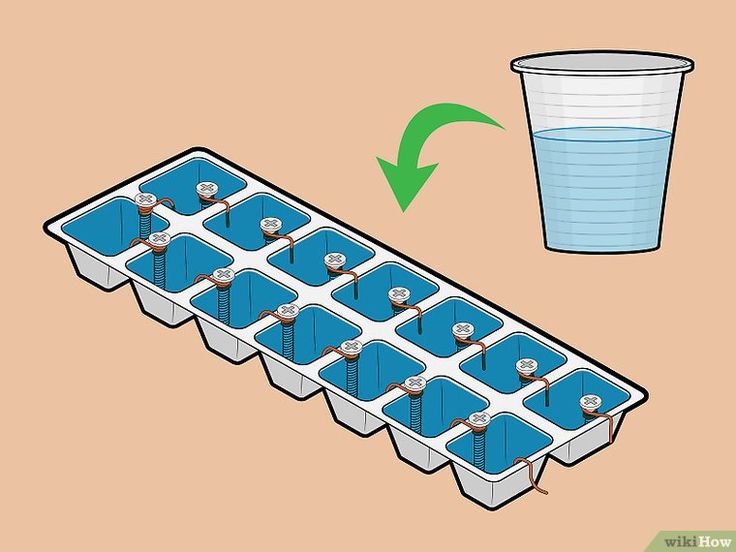 Not having enough water inside the battery will mean that it will not work and might even become so damaged that you must replace the battery.
Not having enough water inside the battery will mean that it will not work and might even become so damaged that you must replace the battery.
There are multiple signs that you must check on the water levels of your battery, each one requiring more knowledge from you to do effectively. These are simple checks that need to be done, like manually checking the water level, to the complicated like measuring how the battery reacts to charging and being used.
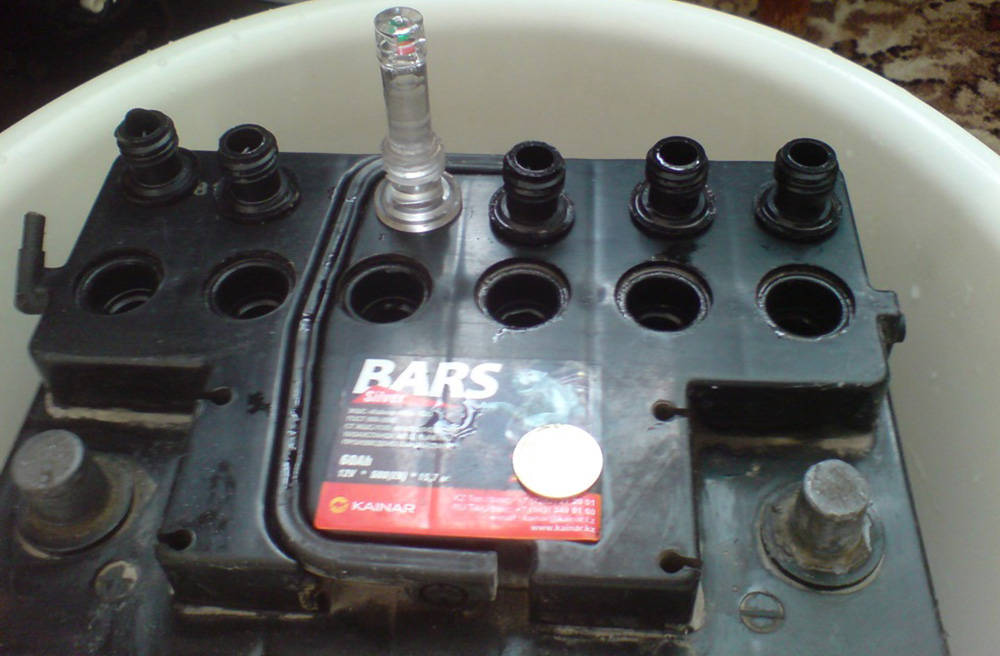 This means that the water will start to boil away, causing your battery to literally produce bubbling noises as the water heats up more and more.
This means that the water will start to boil away, causing your battery to literally produce bubbling noises as the water heats up more and more.There is only one type of water that should be added to your lead acid battery, distilled water. This is not normal water that has been filtered or simply cleaned. This is specialized water that you can only get at specific locations; luckily, both are just around the corner of most people.
This is not normal water that has been filtered or simply cleaned. This is specialized water that you can only get at specific locations; luckily, both are just around the corner of most people.
At the same place where you can buy oil and other parts for your ATV, even new batteries, you can buy distilled water. Unlike other locations, you can buy larger quantities as these stores will be aware that you may need more than would be used in medical applications.
You can easily buy five liters of water at a time; however, they will require that you explain to them how you are going to use the water. This is because distilled water can be hazardous when consumed by water.
Because much medical equipment needs to undergo special cleaning processes, pharmacies can provide distilled water if needed. However, because medical equipment does not require as much distilled water, you will only be able to refill your ATV a little bit at a time.
Usually, pharmacies sell up to one-liter bottles of distilled water that can be used for your lead-acid batteries.
If you do not use your ATV regularly or you use it almost every weekend, there are different times and places you should be checking the water levels of your battery.
If you use your ATV almost every weekend, you may have to check your battery quite regularly, as you will be charging and discharging battery all the time. During treks through forests, across deserts, or even just trips down the road, your battery will be used repeatedly.
As this is what can boil away the water in your lead-acid battery, then you will find that you need to check on your water levels more often. Simply checking the water levels every month or two will be sufficient to ensure no damage to your battery is done.
Sometimes ATVs are only used once or twice a year when you go to visit vacation homes, or you may find yourselves not being able to go out and have fun with them easily. Therefore, you will need to check on your battery levels before you go on vacation.
Therefore, you will need to check on your battery levels before you go on vacation.
If you have an ATV at your vacation location, then you will need to check on the battery before you go, and maybe bring an extra battery with you, this would be easier than relying on a battery that has been standing for a year or more.
It is recommended that you replace your batteries often if your ATV experiences large amounts of use. This can mean replacing the battery yearly, or you may want to replace the battery ever time your use your ATV.
If you are willing to make some upgrades to your ATV, you may consider replacing the lead-acid battery with a lithium-ion battery that will last a lot longer.
These are the things you will need to do with your lead-acid battery, checking up on it often, and seeing how your ATV reacts to certain things will tell you how long it still can go. Having a perfectly working lead-acid battery will mean more hours of fun without headaches of being jumpstarted or push to start.
Get your battery filled, take your ATV somewhere wild, and have some wild fun without a care in the world!
The ATV battery is one of the most important elements in its electrical system. Given the amount of additional equipment installed on the ATV (winches, additional lights, alarms, heating, etc.), the battery often does not charge to the end. And the owners do not pay due attention to this, which is why they change the battery every season. Believe me, with proper care, the battery can last 3 or more seasons. Let's pay attention to the rules for charging your ATV battery, consider errors and answer questions that arise when servicing the battery.
Warning. The conversation for the most part will be about serviced batteries. Maintenance free ones have no plugs (at the top of the battery) and only need a timely and full charge, and their owners may skip some of the points described below.
Can I use a car charger to charge my ATV battery?
It is possible, in the case when the charger has a charge current adjustment and it is possible to set the minimum current from 0. 5 to 0.7.A. There is a simple rule: one tenth of the battery capacity will be considered the normal current for charging (calculation should be made in Amperes). Of course, it is much easier and more correct to use special devices designed for low charging current. Complete with the charger always comes instructions for use, which contains the basic requirements and rules, do not neglect to read it.
5 to 0.7.A. There is a simple rule: one tenth of the battery capacity will be considered the normal current for charging (calculation should be made in Amperes). Of course, it is much easier and more correct to use special devices designed for low charging current. Complete with the charger always comes instructions for use, which contains the basic requirements and rules, do not neglect to read it.
Is charging noise and boiling normal?
Moderate boiling is normal. This is explained by the reaction in which the electrolyte enters with lead plates, in which the acid releases a certain amount of gas. It is worth worrying if the boiling is excessively strong - this indicates that the charge current has been exceeded.
Why does a new battery drain quickly?
 6 volts;
6 volts; What is sulfation?
Sulfation is the formation of lead sulfate (white matter) on the battery plates.
All old and failed batteries are subject to this phenomenon.
What affects the sulfation process?
How to avoid sulfation?
Monitor the condition of the ATV's electrical system at all times. The battery loses its charge significantly during the engine start, and the charge must be replenished when driving, so monitor the health of the regulator and generator relays. When the ATV is not used for a long time, remove the battery and charge it with the charger at least once every 2 months. When the first signs of sulfation appear, charge the battery with low current for a long time (up to 2 or more days).
The battery loses its charge significantly during the engine start, and the charge must be replenished when driving, so monitor the health of the regulator and generator relays. When the ATV is not used for a long time, remove the battery and charge it with the charger at least once every 2 months. When the first signs of sulfation appear, charge the battery with low current for a long time (up to 2 or more days).
Amps / hours - what is the characteristic?
This is the unit in which the battery capacity is measured. For example, a fully charged battery with a capacity of 1 Ah should theoretically provide a current of 1 ampere for an hour.
How and why to monitor the electrolyte level?
The electrolyte is sulfuric acid diluted with water in the right proportion. During operation, water evaporates, and the proportion of sulfuric acid increases, which, in turn, adversely affects the health of the battery.
If the electrolyte level drops (each battery has a normal level mark), add distilled water (available from auto parts stores) to the mark.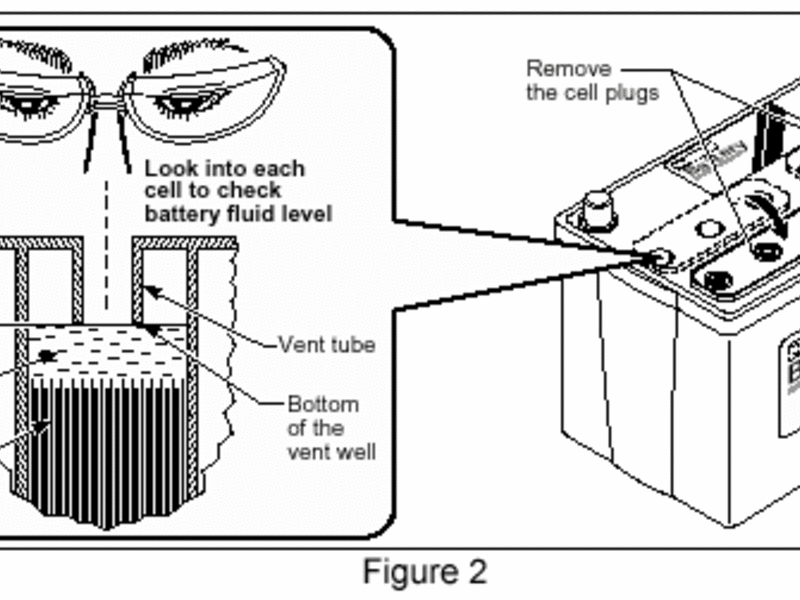
How can I tell if the battery is charged?
A charged battery produces 12.8V. If your multimeter measures 12.5V or less, the battery needs to be charged.
Which terminal should be connected first when installing the battery on the ATV?
Always connect the positive terminal first. When connecting the wire to the terminal, a spark may occur, so all flammable liquids must be removed in advance. Always tighten the bolts on the terminals firmly to avoid short circuits. The terminals can be treated with a lubricant to prevent oxidation.
What happens if the polarity is reversed?
Always respect the polarity - wrong polarity can lead to a blown fuse at best and an exploding battery at worst.
How to store the battery in winter?
If you do not use the ATV in winter, the battery must be removed and stored in a cool place, and charged several times during the winter with a small current.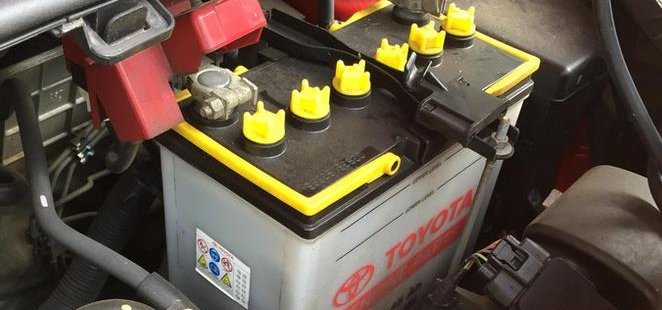
As you can see, there are no difficulties in maintaining the battery, following simple rules will significantly extend battery life and save your finances.
And how to properly charge the battery, we will learn by watching the video.
Buying a children's ATV or its adult equivalent is not just about being a rider. This technique requires special attention. As a rule, the owners of this motorcycle often do not pay enough attention to charging the battery, which can cause it to fail almost every season. Remember, if you charge your ATV battery correctly, it will last you many times longer.
To avoid premature battery failure and loss of battery capacity, follow these guidelines:

Always follow the connection diagram when installing the battery in the ATV. You need to start by connecting the positive terminal. Be careful not to reverse the polarity as this can cause both the fuse to blow and the battery to explode.
If the vehicle battery suddenly stops charging, there may be several reasons for this:
The first signs of regulator relay failure are when the ATV battery starts to drain too quickly. Diagnosis of such a breakdown is carried out by measuring the resistance with a voltmeter at the battery terminals. Repairing any electrical equipment of an ATV is a rather complicated process that a true professional should perform.
Often the best solution when a battery or regulator fails is to replace it with a new one.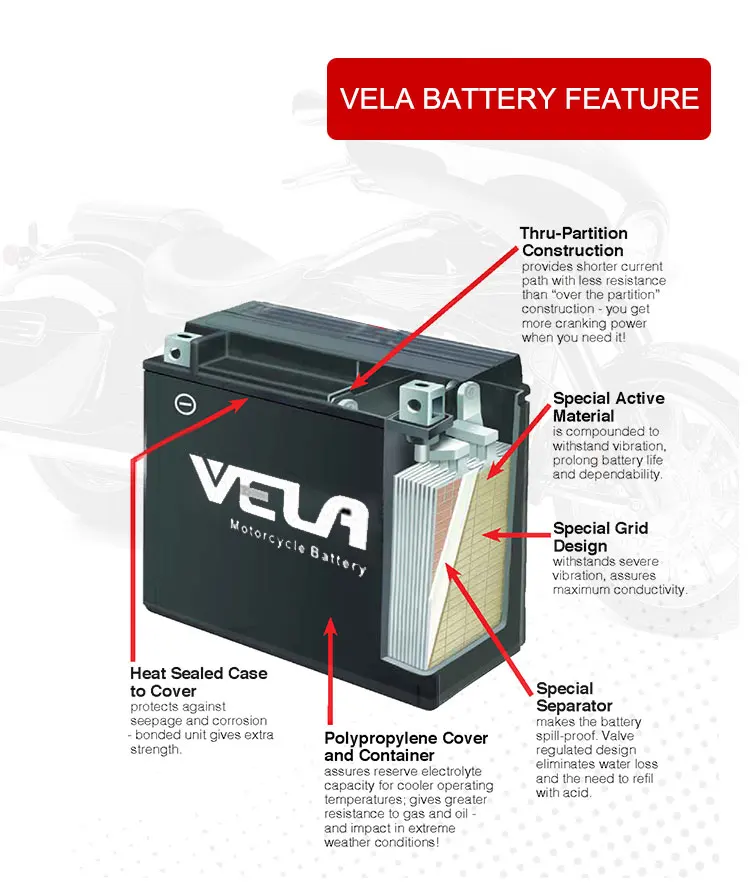 It is much easier to prevent this kind of breakdown than to fix it later. That is why it is necessary to charge the battery of motor vehicles in strict accordance with the requirements of the manufacturer.
It is much easier to prevent this kind of breakdown than to fix it later. That is why it is necessary to charge the battery of motor vehicles in strict accordance with the requirements of the manufacturer.
There are two ways to charge the child ATV battery with the charger. The easiest of them is to connect the charger to the appropriate connector on the motorcycle. True, such a nest is not available on all models of ATVs. If there is no such connector, then the battery should be connected directly to the charger. The battery is charged as follows:
Lithium ATV batteries usually have a board that monitors the battery level. But even in this case, it is strongly not recommended to charge the device longer than necessary.
But even in this case, it is strongly not recommended to charge the device longer than necessary.
Each ATV gel battery manufacturer provides detailed charging instructions. It is very important to choose the right charger with the ability to adjust the amperage in order to avoid overcharging the battery. On sale you can find specialized chargers for ATV gel batteries.
It is necessary to charge such a battery as follows:
